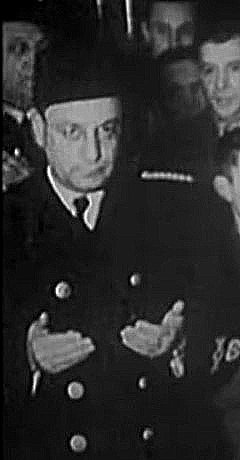
Lika is a traditional region of Croatia proper, roughly bound by the Velebit mountain from the southwest and the Plješevica mountain from the northeast. On the north-west end Lika is bounded by Ogulin-Plaški basin, and on the south-east by the Malovan pass. Today most of the territory of Lika is part of Lika-Senj County. Josipdol, Plaški and Saborsko are part of Karlovac County and Gračac is part of Zadar County.

Večernji list is a Croatian daily newspaper published in Zagreb.

Mile Budak was a Croatian politician and writer best known as one of the chief ideologists of the Croatian fascist Ustaša movement, which ruled the Independent State of Croatia during World War II in Yugoslavia from 1941–45 and waged a genocidal campaign of extermination against its Roma and Jewish population, and of extermination, expulsion and religious conversion against its Serb population.

Nikola Mandić was a Croatian politician and one of the leading political figures in Bosnia and Herzegovina under Austrian-Hungarian rule. He also served as a Prime Minister of the Independent State of Croatia (NDH) during World War II. He was executed by the Yugoslav Partisans as a war criminal on 7 June 1945.

Julije Makanec was a Croatian politician, teacher, philosopher and writer. During the World War II in Yugoslavia, he was the Minister of Education of the Independent State of Croatia and a high-ranking member of the Ustashas.
Ban of Croatia was the title of local rulers or office holders and after 1102, viceroys of Croatia. From the earliest periods of the Croatian state, some provinces were ruled by bans as a ruler's representative (viceroy) and supreme military commander. In the 18th century, Croatian bans eventually became the chief government officials in Croatia.
In Croatia, there are over 2,900 people who consider themselves German, most of these Danube Swabians. Germans are officially recognized as an autochthonous national minority, and as such, they elect a special representative to the Croatian Parliament, shared with members of eleven other national minorities. They are mainly concentrated in the area around Osijek in eastern Slavonia.

The Croatian Armed Forces were formed in 1944 with the uniting of the Croatian Home Guard and the Ustaše Militia in the Independent State of Croatia (NDH). It was established by the fascist Ustaše regime of Ante Pavelić in the NDH an Axis puppet state in Yugoslavia during World War II.
The Croatian Publishing and Bibliographic Institute was a lexicographic institute in the Independent State of Croatia founded on August 9, 1941. Mate Ujević was its director. In 1944, Dragutin Tadijanović became the literary secretary of the institute. With the creation of communist Yugoslavia in 1945, the institute's work was stopped.
The Main Ustaša Headquarters was the ruling body of the Ustaša party in the Independent State of Croatia, convened under the poglavnik, Ante Pavelić.

Hönigsberg & Deutsch was an architecture studio and construction company formed in Zagreb by architects Leo Hönigsberg and Julio Deutsch, active between 1889 and 1911. They produced over 90 known works in the Lower Town area of Zagreb, built during the redevelopment in the years following the 1880 Zagreb earthquake. The majority of these were residential houses, but they also designed manufacturing plants, synagogues and public institution buildings.
The Velebit uprising or Lika uprising was a minor action carried out by Ustaše militias against a Yugoslav gendarmerie station on 6 and 7 September 1932.

Ademaga Mešcić or Adem Aga Mešcić was a Bosnian politician and military officer who served in the Austro-Hungarian Schutzkorps, and later a member of the Ustaše government of the Independent State of Croatia for Bosnian region during World War II.
Cvitan Spužević was a Yugoslav lawyer, politician and humanitarian. As a Croat from Bosnia-Herzegovina, during World War II he was a member of the ZAVNOBiH and was later appointed as a minister in the first government of People's Republic of Bosnia and Herzegovina from 1945 to 1946.

Svetozar Rittig was a Croatian Catholic priest, historian and politician.

Alija Šuljak (1901–1992) was a prominent Bosnian Muslim Croat who was a professor, politician and military officer of Ustaše during World War II, best known as one of the main perpetrators of the genocide of Serbs in Eastern Herzegovina.
Neven Budak is a Croatian historian and professor at the Faculty of Humanities and Social Sciences, University of Zagreb.
Nikola Stojanović was a lawyer and Bosnian Serb and Yugoslavian politician. As a student, he wrote the article Serbs and Croats, printed in the Serbian Literary Herald, applying Social Darwinism and claiming that Serbs as 'superior people' would eventually assimilate the Croats. In the text, Stojanović announced war to extermination of either Serbs or Croats and the text has been cited as the blueprint for ethnic cleansing by Croatian writers. Following a politically-motivated reprint of the article in Srbobran, the newspaper of the Serb Independent Party in Zagreb, it led to 1902 riots targeting Serb businesses and homes in the city, involving a crowd of about 20,000.